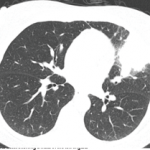Clinical experience has taught us that the sign of clubbing is more likely to be the harbinger of a deadlier disease than a lung infection, namely lung cancer. In effect, clubbing became one of the first paraneoplastic signs. With the exception of an earlier report in the French literature published near the end of the 19th century that first described a link between cancer and possible paraneoplastic findings affecting the central nervous system, clubbing opened clinicians’ eyes and minds to the concept that occult malignant disease can leave important clues at distant sites, far removed from the tumor.5 One only needs to know where to look.
It’s All in the Hands
One of the most intellectually satisfying aspects of our specialty is how, just by using our eyes and our minds, we can often spot precious clinical pearls that may instantly define a diagnosis. Although these clues may seem obvious to us, other physicians who rely less on the physical exam and more on advanced technology often overlook these leads. Save for the esoteric labs and the costly imaging, our services come cheap.
Let’s go back to looking at the hands in search of other potentially paraneoplastic findings. Similar to clubbing, the appearance of acanthosis palmaris can herald a lung or gastric malignancy. The palms have a velvety smooth pink appearance, reminding some observers (no doubt, devotees of the whole animal consumption movement) of tripe, that edible offal made from the stomach linings of various large farm animals. Hence, this sign may be better known by its gastronomic appellation, tripe palms.
Other hand features may seem odd or obscure to some but are readily recognized by rheumatologists as potentially pointing to unfavorable diagnoses. For example, the curious swelling syndrome that may erupt in the hands of older men, remitting seronegative symmetrical synovitis with pitting edema (RS3PE), has been implicated by various authors as signifying a paraneoplastic finding. After all, reports suggest that nearly one-quarter of afflicted individuals develop a malignancy, although given the advanced age of most patients with RS3PE, this may not be as robust an association as it sounds.4
In another disorder, the palmar fasciitis and polyarthritis syndrome that generally affects older women, the deeper tissues of the hands may initially become painfully swollen, only to quickly shrivel and severely contract. The hallmark feature is inflammation of the palmar fascia, which leads to flexion contractures with nodular thickening similar to, but more severe than, those seen with Dupuytren’s contracture.6 These hard, indurated tissues give the appearance of woody hands, another ominous sign that often foreshadows an occult malignancy involving the female reproductive organs, especially the ovaries. In some unfortunate individuals, digital ischemia may evolve to gangrene, heralding an intra-abdominal tumor. This is the paradox of paraneoplasia, in which musculoskeletal manifestations that at first glance suggest a primary rheumatologic diagnosis are actually hinting at the actions of distant cancer cells.


